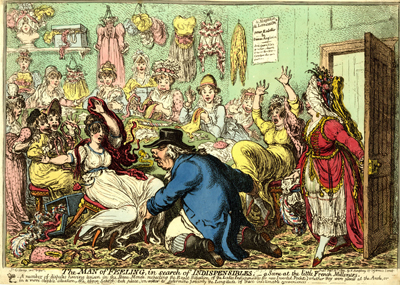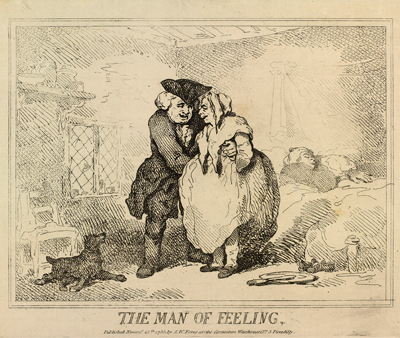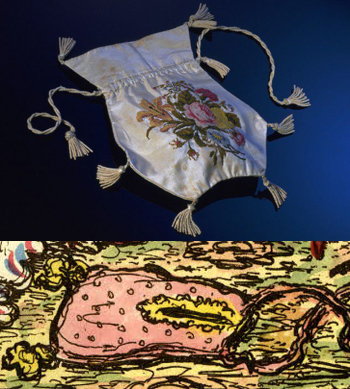The Man of Feeling in Search of Indispensibles. . .
Not surprisingly this is one of the prints that made it on the list of "suppressed" plates in the Bohn edition of Gillray's works in 1851. The print shows William V, Prince of Orange, at a dressmaker's shop with both hands up the skirts of the two women in the foreground. According to the accompanying tongue in cheek description, he is satisfying the curiosity of inquiring minds among the beau monde about the precise location of women's "indispensibles."

© Trustees of the British Museum
Gillray's thoroughly ironic title, The Man of Feeling, is taken from the hugely popular sentimental novel of the same name written by Henry Mackenzie and published in 1771. It featured a central character Harley, whose extreme empathy for the downtrodden is displayed over and over, often to his own distress.
As the craze for this sort of "sensibility" wore off, however, the comic and sexually suggestive possibilities of the title were exploited by caricaturists like Henry William Bunbury and Thomas Rowlandson—the humorous opportunities by Bunbury and the suggestive and erotic ones (naturally) by Rowlandson (in several different prints with the same name). Gillray's appropriation of the title was consequently well established.

The Man of Feeling
[1785]
© Royal Collection Trust
The hereditary Prince of Orange had taken refuge in England after the French invaded Holland in 1795. While in exile, he had a reputation for sexual promiscuity that Gillray had no qualms about exploiting. In 1796, for instance, Gillray had portrayed him as a Dutch Cupid in an Orangerie surrounded by pregnant servant girls, the fruits of his labours. Here the Prince enjoys the apparent prerogative of great men everywhere according to a recent American expert.
Reticules, or "Indespensables" as they were sometimes called, were handbags or purses which in 1799 had now become a necessity as women's dresses, following French fashions, became ever more sheer and clinging. Traditional "pockets" that used to be sewn into dresses were now viewed as too awkward and conspicuous disrupting the lines of the latest form-fitting fashions. "Indispensables" had a drawstring mouth and could attached at the waist (outside the dress) or (more frequently) held in hand, suggesting that the Prince, in Gillray's view, was groping for a very different kind of indispensable. And in fact the opening of the most conspicuous reticule in the print is not really designed to look like a reticule but a vagina.

© Victoria & Albert Museum, London
compared to Gillray's.
The primary object of Gillray's satire is, of course, the degenerate Prince of Orange. But by locating Wiiliam V's actions in a French dressmaker's shop ("le Magasin de Lancastre") with a proprietor who looks more like a bawd than a dressmaker, and with a placard on the wall with an advertisement in French ("pour Embellir les Dames Angloise") Gillray is also taking his customary swipe at French values.
Sources and Reading
- Commentary from the British Museum on The Man of Feeling in Search of Indispensibles. . ..
- "William V, Prince of Orange," Wikipedia
- "The Man of Feeling," Wikipedia
- "Reticule (handbag)," Wikipedia
- "Terminology: What is a reticule or indispensable?" The Dreamstress
Comments & Corrections
NOTE: Comments and/or corrections are always appreciated. To make that easier, I have included a form below that you can use. I promise never to share any of the info provided without your express permission.